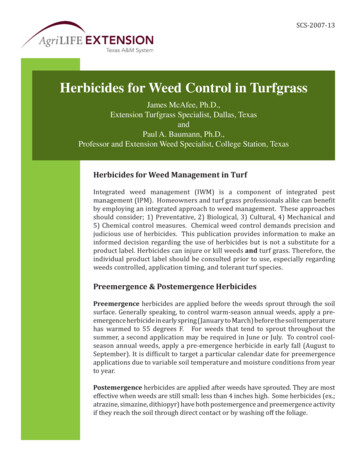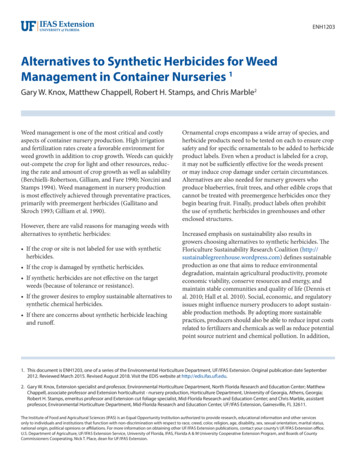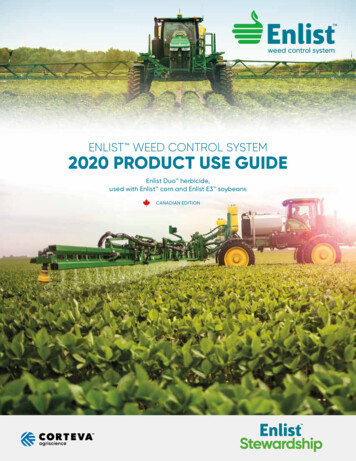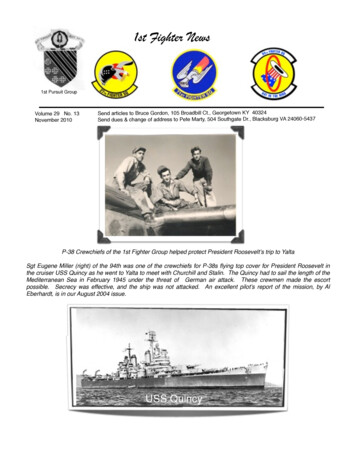
Transcription
SCS-2007-13Herbicides for Weed Control in TurfgrassJames McAfee, Ph.D.,Extension Turfgrass Specialist, Dallas, TexasandPaul A. Baumann, Ph.D.,Professor and Extension Weed Specialist, College Station, TexasHerbicides for Weed Management in TurfIntegrated weed management (IWM) is a component of integrated pestmanagement (IPM). Homeowners and turf grass professionals alike can benefitby employing an integrated approach to weed management. These approachesshould consider; 1) Preventative, 2) Biological, 3) Cultural, 4) Mechanical and5) Chemical control measures. Chemical weed control demands precision andjudicious use of herbicides. This publication provides information to make aninformed decision regarding the use of herbicides but is not a substitute for aproduct label. Herbicides can injure or kill weeds and turf grass. Therefore, theindividual product label should be consulted prior to use, especially regardingweeds controlled, application timing, and tolerant turf species.Preemergence & Postemergence HerbicidesPreemergence herbicides are applied before the weeds sprout through the soilsurface. Generally speaking, to control warm-season annual weeds, apply a preemergence herbicide in early spring (January to March) before the soil temperaturehas warmed to 55 degrees F. For weeds that tend to sprout throughout thesummer, a second application may be required in June or July. To control coolseason annual weeds, apply a pre-emergence herbicide in early fall (August toSeptember). It is difficult to target a particular calendar date for preemergenceapplications due to variable soil temperature and moisture conditions from yearto year.Postemergence herbicides are applied after weeds have sprouted. They are mosteffective when weeds are still small: less than 4 inches high. Some herbicides (ex.;atrazine, simazine, dithiopyr) have both postemergence and preemergence activityif they reach the soil through direct contact or by washing off the foliage.
Contact and Systemic HerbicidesContact herbicides (ex.; paraquat, diquat) causedamage wherever they touch a plant. To work well, acontact herbicide should thoroughly cover the leavesand stems. Contact herbicides work best on smallannual weeds. They have little effect on perennialweeds unless applications are repeated. Most contactherbicides work very quickly (1-3 days).Systemic herbicides (ex.; 2,4-D, glyphosate)are absorbed and moved throughout the plant.They are sometimes applied to the foliage andsometimes to the soil although some systemicherbicides such as glyphosate are inactivated bycontact with clay particles in the soil. They canbe absorbed and translocated (moved) from thefoliage, roots or stems to other parts of the plant.Systemic herbicides work well on perennial weedsbecause the herbicide is moved to parts of theplant other than where it was applied. This featureis particularly valuable for killing root, tuber andrhizome growth on perennial weeds.Selective and Non-Selective HerbicidesSelective herbicides kill one type of plantbut not another–for example, grass weeds butnot broad-leaved weeds. This selectivity maybe due to differences in herbicide absorption,translocation or physiological differencesbetween weeds and the turfgrass.Nonselective herbicides kill almost all kindsof plants. Use them very carefully in lawns, andbe sure to keep them away from shrubs andbedding plants. Some of these (ex.; glyphosateand paraquat) are “inactivated” once they come incontact with the soil and are therefore useful whenapplied prior to establishing a new turf stand.Broadleaf Weeds, Grasses and SedgesBroadleaf weeds have two seed leaves (firstleaves) as they emerge through the soil. Theirleaves are generally wider than those of grassweeds. Veins on the leaves are branched or netlike. Their stems are oval, round or square and areoften branched. They may have showy flowers.Grass weeds have only one seed leaf. Theirleaf blades are narrow and have parallel veins.Stems are round or oval. They may developseed heads at the ends of the stems, but ifthey have flowers they will be inconspicuous.Sedges look a lot like grasses but their stemsare triangular. Their leaves are usually shinyand smooth. Sedges often have “nuts” or tubersattached to their roots. In purple nutsedge,several tubers can be connected in a “chain”.Annual, Biennial and Perennial WeedsAnnual weeds germinate from seed each yearand live for one growing season. Summer annualsgerminate in the spring and die back in the fall.Winter annuals germinate in late summer orearly fall and die the following spring or summer.Annual weeds can produce thousands of seedsper plant which can germinate for many yearsafter the seed has been shed by lying “dormant”in the soil until light, temperature and moistureconditions are adequate for germination. Mostannual weeds will not germinate below a 1 inchsoil depth unless they are large-seeded ( 1/8”in diameter).Biennials have a 2-year life cycle. Theygerminate, emerge, and usually form a rosette(radial cluster of leaves close to the ground) inthe first year. The second year, the plant bolts(produces a flower stalk), flowers, sets seed,matures, then dies.Perennials live 3 years or more. Some reproduceby seed, and some reproduce by creeping stemsthat can be either above-ground (stolons) orbelow-ground (rhizomes). Sometimes, as innutsedges, the rhizomes produce tubers fromwhich new plants grow. Many a homeowner hasdiscovered that what appeared to be individualnutsedge plants in the flower bed were actuallya series of plants that have sprouted from theseconnected tubers. If the stolens, rhizomes, ortubers are broken or separated into pieces, newplants can form from these pieces and spreadthe weed. Therefore, tillage or hand pullingis discouraged when trying to eradicate mostperennial weeds.
Herbicide NamesIndividual herbicide products have what wouldbe considered three names; trade, common, andchemical. Examples of these names for one productare as follows; Roundup (trade name), glyphosateAnnual Grass WeedsField SandburGoosegrassJunglerice(common name) and N-(phosponomethyl) glycine(chemical name). This publication will focus onthe common name, often referred to as the activeingredient on the label. This name could be thesame across a number of different trade namedproducts but still perform the same.PREEMERGENCE HERBICIDESAnnual Grass Weed ControlCommon NameTrade Name(s)atrazineAtrazine 4L, Aatrex 4L, Purge 4LbenefinBalan 2.5G, Balan 60 DF, 2.5 BenefinGranulesbenefin oryzalinXL 2G, Excel-5 Plusbenefin oxadiazonRegal Starbenefin trifluralinTeam 2G, Team ProbensulideBetasan, Bensumec, PreSan,Weedgrass Preventorbensulide oxadiazonGoose/Crab ControldithiopyrDimension, Ultra WSPethofumesatePrograss 1.5 ECmetolachlorPennant Magnum 7.62 ECoryzalinSurflan 4 ASoxadiazonRonstar¹pendimethalinPendulum (several), Pre-MprodiamineBarricade, Endurance, Factor,RegalKade GpronamideKerbsimazinePrincep 4L, Simazine 4L, Simtrol 4L1. Not for use in residential lawns.Annual Broadleaf Weed ControlCommon NameTrade Name(s)isoxabenGalleryethofumesatePrograss 1.5 ECSedge Control or SuppressionmetolachlorRescuegrassSmooth CrabgrassPennant Magnum 7.62 ECSprangletop
Annual Broadleaf WeedsFalse DandelionPOSTEMERGENCE HERBICIDESBroadleaf Weed ControlCommon NameBracted PlantainBurcloverTrade Name(s)atrazineAtrazine, Aatrex 4L, Purge pyralidLontrel¹diquatReward Landscape & Aquatic HerbicideethofumesatePrograss 1.5 nImageMCPAMCPA L.V. 4 EsterMCPA, MCPP, dicambaTriPower Selective, EncoreMCPA, MCPP, dicamba, carfentrazonePowerzoneMCPA, triclopyr, dicambaTruPowerMCPA, fluroxypyr, dicambaTruPower 2Mecroprop (MCPP)MCPP-4 amine, Mecomec 2.5 ECMCPP, 2,4-D, dicambaTrimec Southern, Lesco Three WaySelective, Bentgrass Selective, Triplet SFMCPA, triclopyr, dicambaCool Power Ester, Lesco Eliminate,Three Way Ester II Sensitive, Horsepowermetsulfuron-methylBlade, Manorpyraflufen ethylOctane¹quincloracDrivetriclopyrTurflon Estertriclopyr, clopyralidConfront¹2,4-DDymec, WEEDestroy AM-40 Amine,Hardball, Lesco A-4DCarolina Geranium2,4-D, 2,4-DPPatron 170 Ester2,4-D, clopyralid, dicambaMillennium Ultra2,4-D, clopyralid, dicamba, MSMAMillennium Ultra Plus2,4-D, dicambaLesco Eight-One2,4-D, MCPP, dicambaThree-Way Selective, Trimec Southern,Trimec Bentgrass, Trimec Classic,Trimec Turf HerbicideCarpetweed2,4-D, MCPP-p, dicambaTriplet HI-D, Triplet Selective2,4-D, MCPP, dicamba, carfentrazoneSpeedzone, Speedzone Southern2,4-D, MCPP, dicamba, sulfentrazoneSurge2,4-D, MCPP, 2,4-DPDissolve, Triamine2,4-D, triclopyr, clopyralidMomentum2,4-D, triclopyrChaserMSMA, 2,4-D, MCPP, dicambaTrimec PlustrifloxysulfuronMonument1. Not for use in residential lawns.
CudweedAnnual Broadleaf WeedsSlender AsterOxalisEcliptaPortulacaAnnual SowthistleField Madder (sherardia)PuncturevineSpotted SpurgeHenbitPurslaneSprawling HorseweedMouseear ChickweedCommon MallowLawn Burweed
Perennial Grass WeedsDallisgrassGrass Weed ControlCommon NameKnotroot BristlegrassTrade Name(s)chlorsulfuronCorsairdiquatReward Landscape & Aquatic HerbicideethofumesatePrograss 1.5 ronRevolver³fluazifop-p-butylFusilade II²metribuzinSencor 75Wmetsulfuron-methylBlade, ManorMSMAMSMA 6 Plus, Bueno 6, Target 6.6, MSMAPlus HC, TurfMax 6 Plus, MSMA TurfHerbicide, Lesco Soluble MSMA GranulesMSMA, 2,4-D, MCPP, dicambaTrimec 1. For grassy weed control in cool season turfgrasses.2. For control of grassy weeds in zoysiagrasses.3. Primarily used for poa annua control and as ryegrass transition aid.VaseygrassNutsedge ControlCommon NameTrade Name(s)bentazonBasagran T/O, ronMonumentWild OnionNON-SELECTIVE HERBICIDESCommon NameTrade Name(s)glufosinateFinaleglyphosateGlypro Plus, Roundup, Roundup Pro,Roundup Pro Dry, Roundup Quick Pro,AquaMaster, Prosecutor, Touchdown ProWhile this is not a complete list of herbicides for weed control in turfgrasses, it does contain the majority of commonly used or found herbicides. This is a working list and will be updated on a regular basis as moreherbicides become registered for use in turfgrasses.Always advise individuals to read the label carefully before purchasing andbefore using to make sure the herbicide is labeled for the weeds needingcontrolled and that the herbicide is labeled for the turfgrass species theweeds are found. Also, registration for these different herbicides couldchange over time.
Perennial Grass WeedsKR BluestemBahiagrassSmutgrassDandelionAsiatic e CloverVirginia ButtonweedWater HyssopPerennial Broadleaf Weeds
SedgesPurple NutsedgeGreen KyllingaYellow NutsedgeDistinguishing Features of Yellow and Purple NutsedgeTubers (Nuts)YellowPurplePurplePurplePurple Nutsedge Tuber ChainYellowYellowSedges Have aTriangular StemYellow and purple nutsedge can often appear indistinguishable from each other, however, it is important to recognize them in order to choose the appropriate herbicide for control. The flowering parts(seedheads) are often quite different in appearance. Yellow nutsedge flower spikes exhibit an overallyellow appearance and “bottlebrush” look. Purple nutsedge has distinct purple colored flower spikeswith more loosely arranged spikelets. The leaves of yellow nutsedge have a gradual, narrow taper tothe leaf tip while the leaves on purple nutsedge taper much more abruptly. The tubers (nuts) on yellownutsedge are usually without hairs while the tubers of purple nutsedge are most often covered withthem. In addition, purple nutsedge can have “chains” several tubers long. Yellow nutsedge will onlyhave one tuber connected to a rhizome (thickened root) coming off the parent plant.Produced by the Department of Soil and Crop Sciences, Texas A&M University, College Station, Texas. For further informationgo to www.soilcrop.tamu.edu. The authors may be contacted at JMcAfee@ag.tamu.edu or PBaumann@ag.tamu.edu.The information given herein is for educational purposes only. Reference to commercial products or trade names is made withthe understanding that no discrimination is intended and no endorsement by the Texas AgriLife Extension Service is implied.Educational programs of the Texas AgriLife Extension Service are open to all people without regard to race, color, sex, disability, religion, age,or national origin.
glyphosate Glypro Plus, Roundup, Roundup Pro, Roundup Pro Dry, Roundup Quick Pro, AquaMaster, Prosecutor, Touchdown Pro While this is not a complete list of herbicides for weed control in turf-grasses, it does contain the majority of commonly used or found herbi-cides. This is a working list and will be updated on a regular basis as more










